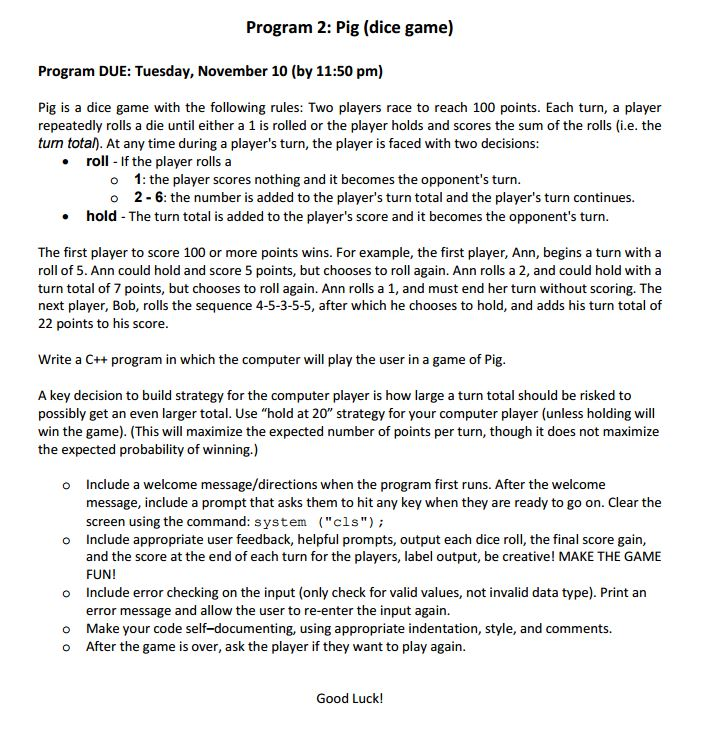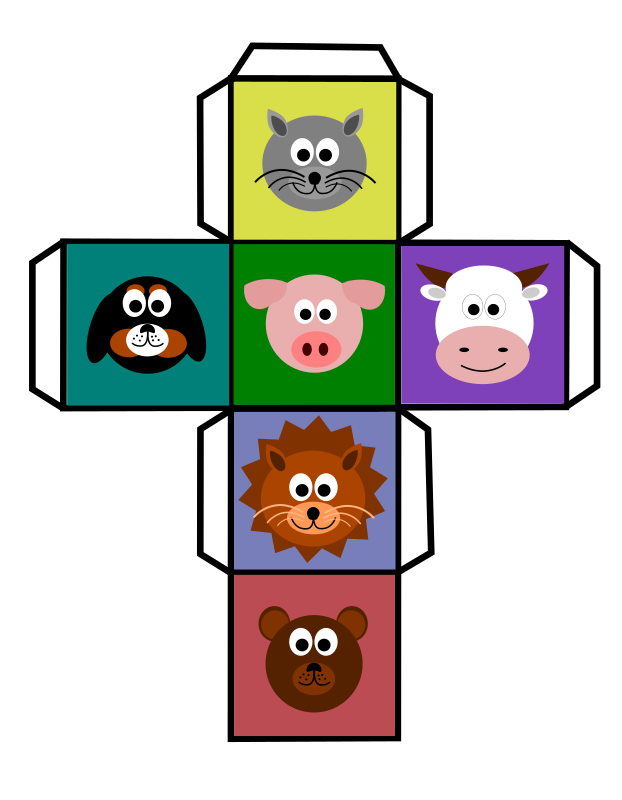How To Play Pig Dice
7/27/2022by admin
How To Play Pig Dice Rating: 5,7/10 8963 reviews
Players: 2 - 6
Ages: 6 and up
Cost: Free!
Math Ideas: Addition, probability
Questions to Ask:
What are the chances I roll a 1 on this turn?
If I want to score 20 points this round, what is the fewest number of times I will need to roll the dice? The most?
- How To Play Dice Game Pig
- How To Play Pig Dice Game Youtube
- Standard Pig Lean Exercise
- Pig Dice Game Rules
- How To Play Greedy Pig Dice Game
- How To Play Pig Dice Game Directions
Let's say I make you a wager. You roll this die a certain number of times. At the end, I'll give you $100, so long as you never roll a 1. If you do end up rolling a 1, then you have to pay me $100.
A simple game, played with one die, which requires a score sheet. Specially marked dice, called 'death dice', are available for this game. They are marked in the same way as standard dice except that the 1-spot is replaced with a skull. This video tutorial will teach you how to play the dice game Pig. This video will teach you the general concepts and game play of Pig. This tutorial is perf. Big Pig This variation is played with two dice. It is like Pig: on your turn you can roll or hold. If you roll a 1, you lose your points for that turn and your turn ends. However, you roll a pair of 1s, add 25 to your turn total. If other doubles are rolled, the player adds twice the value of the dice to the turn total.
- How to play Pass the Pigs dice (pig) game.
- Try your luck using pigs as dice! A classic game for generations and probably the best dice game ever! These pigs are truly addictive! Throw the pigs - how they fall determines the points you get. Use the pigs as dice, and try your luck. First player to score 100 points wins the game. Suitable for players aged eight and over.
How many rolls of the dice would you risk? Surely, you'd roll once, right? After all, the odds of winning are 5 out of 6. But only a fool would roll that die 30 or 50 or 100 times in a row.
So when does some outcome change from 'unlikely' to 'likely'? And how can you help your kids build an intuition for that idea, before they start wasting all their money on lottery tickets?
Maybe a quick game of Pig might help.

How to Play
Pig is typically played with 2-6 people. Each player needs a pencil and paper, as well as a single shared die.
On your turn, you roll the die. If you roll a 1, tough luck. Your turn is over and play passes to the next person. If you roll any other number (2-6), you add that score to your total.
You may roll the die as many times as you want, and you can end your own turn whenever you want. But if you ever roll a 1, you lose all the points you've gained that round.
So let's say on the first round, you rolled a 6 and decided to end your turn. On the next round, you roll four 5s in a row. Congrats! You have 26 points! But you decide to press your luck and roll one more time, landing on a 1. You lose your 20 points and return to a score of 6.
The first player to get to 50 points (or 100 points for a longer game) is the winner!
Where's the Math?
Pig is my favorite game for teaching a counterintuitive, but important, truth of probability: Unlikely things happen. In fact, unlikely things are very likely to happen, eventually.
How To Play Dice Game Pig
In Pig, the chance of rolling a 1 on the next turn is low. At every point along the way, you can justify one more roll. After all, the chances are only 1 in 6 that you'll lose your points. But the chance of never rolling a 1 on the next 10 turns is even lower. And if you roll the dice 100 times in a row, you're practically guaranteed to roll a 1 at some point.
So your child has to start thinking about how to make decisions about uncertain outcomes. Do they roll until they get 20 points, then end their turn no matter what? Do they roll the dice 5 times in a row and then end? Or do they, like most kids, get sucked into the siren's call of 3s and 4s and 5s, constantly telling themselves 'one more roll. Just one more and then I'm done.'
(By the way, as a parent, this game is a great way to determine which of your kids should NEVER go to Vegas)
Pig builds an intuitive understanding of chance and probability that is much more engaging than most games. Sure, there's an element of chance in just about every game. But Pig brings all that chance straight to the forefront of your child's mind, as they decide whether to keep their points or risk another role. This intuitive understanding of chance will give them a great foundation for a more formal academic exploration of probability in middle school.
This game is really popular in elementary classrooms because it also helps kids practice their addition skills, which is also great. The more math topics you can squeeze into a simple dice game, the better!
Questions to Ask
The big question to ask your child is 'What are the chances of rolling a 1 this time?'
The answer is, of course, 1 in 6. This is always true, no matter what happened last turn or the turn before that. The dice have no memory: they don't know what they rolled last time.
One time I went to a casino and saw all these roulette wheels that had displays, showing the red and black numbers that had won in the past. I always wondered if those displays trick people into making bad bets, waiting for a wheel to hit red seven times in a row, just so they can co bet on black. After all, there's no chance it hits red again, right? (Wrong).
This simple question brings up a deep tension in probability: beforehand, certain outcomes seem very unlikely. But each individual outcome has the same probability, regardless what happened before.
It's incredibly unlikely to flip a coin and land on heads 100 times. But if you've already flipped that coin 99 times and landed on heads 99 times, then what are the chances of landing on heads for that 100th flip? 1 in 2, just like every other coin flip ever.
Another great question to ask is 'Let's set a goal score for this round. If you want to walk away with 20 points this round, what is the fewest number of rolls you'll need? What is the greatest number of rolls you'll need?'
This question will get your kids adding mentally, trying to determine how many 6s, 5s or 4s they need to meet their goal. Then, they will have a better intuitive sense of how risky their goal score is.
So give Pig a try! It's fast, fun, and free. And, of course, there's all that math you can do with it.
How To Play Pig Dice Game Youtube
Pig dice game comes from family of jeopardy dice games. In jeopardy dice games players are allowed to go for bigger gains by taking a risk which also can result in not making any gain at all. The objective of Pig dice game is reach to a certain score before your opponents. Normally the game is played for a score of 100.
Game Play:
Pig dice game is played with a single six-sided die and players are allowed to make any number of rolls in each turn. After each roll the dice value is added to their score for that turn. After each roll player can decide whether to stop rolling and claim the total turn score or continue rolling. If they roll a 1 then they lose all points scored in a particular turn and turn is then passed to the opponent. This has no impact on their overall score. If players decide to stop rolling, they get the points scored so far which is added to their overall score.

Standard Pig Lean Exercise
The first player to score 100 points (or any other predetermined score at the beginning of the game) wins the game.
Learn Pig dice game by playing for a turn below (click box below to load the game)

Click here to open the game on mobile.
Variations:
Two-dice Pig:
Two-dice Pig is played with two six-sided dice and has following rules
- Roll as many times. If none of a dice is a 1, then total is added for the current turn score.
- If a single 1 is rolled, then turn ends and score for that turn is zero.
- In case two 1’s are rolled then turn ends and score for that turn as well as overall score is reset to zero.
Learn Two-dice Pig game by playing for a turn below (click box below to load the game)
Pig Dice Game Rules
Click here to open the game on mobile.
Big Pig:
Big Pig is similar to Two-dice Pig except the following changes in the rules
- Roll as many times. If none of a dice is a 1, then total is added for the current turn score.
- If a single 1 is rolled, then turn ends and score for that turn is zero.
- In case two 1’s are rolled then 25 is added to current turn score.
- If a double is rolled other than 1’s then twice the value of dice is added to the current turn score.
Learn Big Pig game by playing for a turn below (click box below to load the game)
Click here to open the game on mobile.
How To Play Greedy Pig Dice Game

How To Play Pig Dice Game Directions
Additional Resources:
Comments are closed.